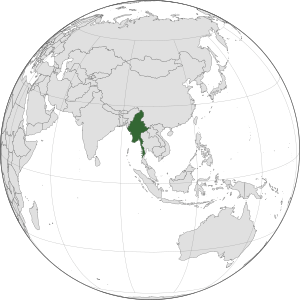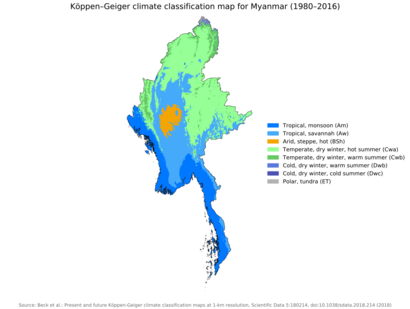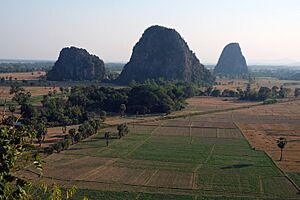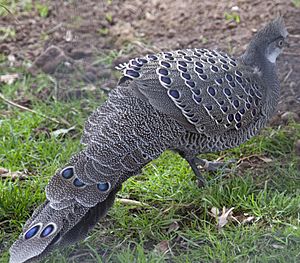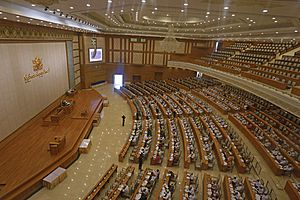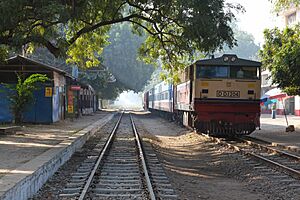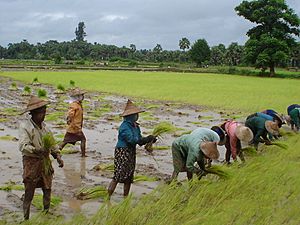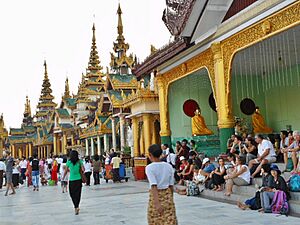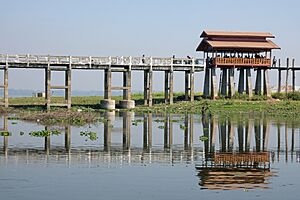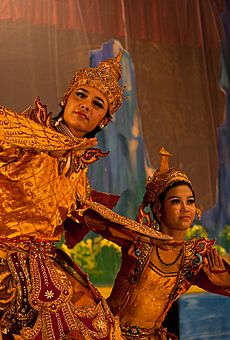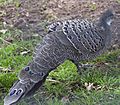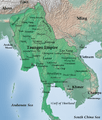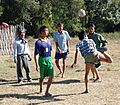Myanmar facts for kids
Quick facts for kids
Republic of the Union of Myanmar
|
|
|---|---|
|
|
|
| Capital | Naypyidaw 21°00′N 96°00′E / 21.000°N 96.000°E |
| Largest city | Yangon |
| Official language | Burmese |
| Recognised regional languages |
|
| Ethnic groups
(2019)
|
|
| Religion |
|
| Demonym(s) |
|
| Government | Unitary assembly-independent republic under a military junta |
|
• Acting President, SAC Chairman, and Prime Minister
|
Min Aung Hlaing |
|
• SAC Vice Chairman and Deputy Prime Minister
|
Soe Win |
| Legislature | State Administration Council |
| Formation | |
| 23 December 849 | |
| 16 October 1510 | |
| 29 February 1752 | |
| 1 January 1886 | |
|
• Independence from the United Kingdom
|
4 January 1948 |
|
• 1962 coup d'état
|
2 March 1962 |
|
• 1988 coup d'état
|
18 September 1988 |
|
• Current constitution
|
31 January 2011 |
| 1 February 2021 | |
| Area | |
|
• Total
|
676,579 km2 (261,229 sq mi) (39th) |
|
• Water (%)
|
3.06 |
| Population | |
|
• 2022 estimate
|
55,770,232 (26th) |
|
• Density
|
196.8/sq mi (76.0/km2) (125th) |
| GDP (PPP) | 2024 estimate |
|
• Total
|
|
|
• Per capita
|
|
| GDP (nominal) | 2024 estimate |
|
• Total
|
|
|
• Per capita
|
|
| Gini (2017) | ▼ 30.7 medium · 106th |
| HDI (2022) | medium · 144th |
| Currency | Kyat (K) (MMK) |
| Time zone | UTC+06:30 (MMT) |
| Driving side | right |
| Calling code | +95 |
| ISO 3166 code | MM |
| Internet TLD | .mm |
Myanmar is a country in Southeast Asia. Its full name is the Republic of the Union of Myanmar. It is also sometimes called Burma. Myanmar is the largest country in South East Asia that is not an island. It is also considered part of South Asia.
Myanmar shares borders with China to the north, Laos to the east, and Thailand to the southeast. To the west, it borders Bangladesh and India. The country also has a long coastline of over 2,000 kilometers (1,240 miles) along the Andaman Sea and the Bay of Bengal.
Contents
Understanding Myanmar's Name
In 1989, the military government changed the country's English name from Burma to Myanmar. They also changed names of places, like Rangoon to Yangon. The name in the local Burmese language, Myanma, stayed the same.
This name change caused some debate. Many people and news groups, like the BBC, still use Burma. However, some important figures, like Aung San Suu Kyi, now use Myanmar.
Exploring Myanmar's Past
Myanmar's history includes early civilizations like the Pyu city-states and Mon kingdoms. In the 9th century, the Bamar people arrived. They formed the Pagan Kingdom around 1050. This led to the spread of the Burmese language, culture, and Theravada Buddhism.
After the Pagan Kingdom fell to Mongol invasions, different states fought for control. In the 16th century, the Toungoo dynasty united the country. For a short time, it was the largest empire in history of Southeast Asia. Later, the Konbaung dynasty ruled a large area in the early 1800s.
The British East India Company took control of Myanmar after three Anglo-Burmese Wars. Myanmar became a British colony. After a brief Japanese occupation during World War II, the Allies took it back. Myanmar gained independence from the United Kingdom on January 4, 1948.
Recent History and Challenges
Since independence, Myanmar has faced ongoing challenges. A military coup in 1962 led to a military dictatorship. In 1988, a large protest called the 8888 Uprising happened. This led to promises of a new government, but the military kept control.
The country has also seen long-running conflicts among its many ethnic groups. In 2011, the military government officially stepped down. A civilian government was then put in place. Aung San Suu Kyi, a well-known political leader, was released from detention. This led to better relationships with other countries.
However, in 2021, the Burmese military again took power in a coup d'état. This action was widely criticized by other countries. It led to many protests and a larger civil war. The military also detained Aung San Suu Kyi.
Geography and Climate
Myanmar covers about 678,500 square kilometers (261,970 square miles). It is located between 9° and 29° North latitude and 92° and 102° East longitude. Its northern border with China is formed by the Hengduan Mountains. Hkakabo Razi in Kachin State is the highest point in Myanmar, standing at 5,881 meters (19,295 feet).
Many mountain ranges run from north to south, including the Rakhine Yoma and Shan Hills. These mountains divide Myanmar's three main river systems: the Irrawaddy, Salween, and Sittaung. The Irrawaddy River is the longest, flowing for nearly 2,170 kilometers (1,350 miles). Most people in Myanmar live in the fertile Irrawaddy valley.
Climate and Weather Patterns
Much of Myanmar lies in the monsoon region. Coastal areas receive a lot of rain, over 5,000 mm (197 inches) annually. The delta region gets about 2,500 mm (98 inches) of rain each year. Central Myanmar's dry zone receives less than 1,000 mm (39 inches).
Northern Myanmar is the coolest, with average temperatures around 21°C (70°F). Coastal and delta regions are warmer, with average maximum temperatures of 32°C (90°F).
Myanmar is very vulnerable to climate change. The country is working to use more renewable energy and reduce carbon emissions. Groups like the United Nations Environment Programme are helping Myanmar prepare for climate change impacts. This includes teaching new farming methods and building stronger infrastructure.
Biodiversity and Nature
Myanmar is rich in biodiversity. It has over 16,000 plant species and many animal species. These include 314 mammals, 1,131 birds, 293 reptiles, and 139 amphibians. The country has large natural ecosystems, but they are threatened by human activities.
Forests cover over 49% of Myanmar. These include dense tropical forests and valuable teak trees. Other trees like acacia, bamboo, and Magnolia champaca are also found. In the northern highlands, you can find oak, pine, and rhododendrons.
Wildlife of Myanmar
Myanmar is home to many jungle animals. You might find rhinoceros, wild water buffalo, clouded leopard, wild boars, and elephants. Elephants are also trained for work in the lumber industry. Smaller mammals include gibbons, monkeys, and flying foxes.
The country has over 800 bird species. These include parrots, myna, peafowl, and herons. Reptiles like crocodiles, geckos, cobras, and Burmese pythons also live here. Hundreds of freshwater fish species are important food sources.
Government and Politics
Myanmar is officially a unitary republic under its 2008 constitution. However, in February 2021, the military took control from the civilian government. The military declared a state of emergency. The Commander-in-Chief of Defence Services, Min Aung Hlaing, became the acting leader.
Myanmar's constitution was written by its military rulers. The country has a parliamentary system with two legislative houses. The military appoints 25% of the lawmakers. The rest are chosen in general elections.
The legislature is called the Assembly of the Union. It has two parts: the 224-seat upper House of Nationalities and the 440-seat lower House of Representatives.
Economy and Resources
Myanmar's economy is growing quickly. In 2019, its economy was valued at about US$76.09 billion. A large part of Myanmar's economy is informal. This means it includes activities not officially recorded, like some trade.
Agriculture: Growing Food for the Nation
Rice is Myanmar's most important farm product. It covers about 60% of all cultivated land. Rice makes up 97% of the country's total food grain production. New rice varieties have helped increase production significantly over the years.
Natural Resources: Gems and Minerals
Myanmar is known for its precious stones. These include rubies, sapphires, pearls, and jade. Rubies are the biggest earner. About 90% of the world's rubies come from Myanmar. The Mogok area is famous for its rare "pigeon's blood" rubies and blue sapphires.
Some international jewelry companies do not buy these stones. This is due to concerns about working conditions in the mines. Also, most profits from mining go to the government. Myanmar also supplies about 10% of the world's Rare-earth elements.
Other industries include farm goods, textiles, wood products, and oil and natural gas.
Tourism: Exploring Myanmar
The government gets a lot of money from tourism. Popular places to visit include big cities like Yangon and Mandalay. Religious sites in Mon State and Bago are also popular. Nature spots like Inle Lake and ancient cities such as Bagan attract visitors. There are also beautiful beaches like Ngapali and Ngwe-Saung.
However, some parts of the country are closed to tourists. Visitors are also advised not to discuss politics with local people. Most travelers arrive by air. It is generally not possible for foreigners to enter Myanmar by bus, train, car, or boat from other countries. However, some border crossings allow private vehicles.
People and Culture
In 2014, Myanmar's population was about 51.4 million people. This number did not include some uncounted areas. Myanmar has a lower population density than many other Southeast Asian countries. Many Myanmar citizens also work in other countries, especially Thailand.
Major Cities in Myanmar
Myanmar has several large cities:
- Yangon (population 5,211,431)
- Mandalay (population 1,225,546)
- Naypyidaw (population 1,160,242)
- Bago (population 491,434)
- Hpa-An (population 421,575)
Diverse Ethnic Groups
Myanmar is home to many different ethnic groups. There are at least 108 distinct groups. Most are Tibeto-Burman peoples. There are also groups speaking Tai–Kadai, Hmong–Mien, and Austroasiatic languages.
The Bamar make up about 68% of the population. The Shan are about 10%, and the Kayin are 7%.
Languages Spoken in Myanmar
Burmese is the official language and the mother tongue of the Bamar people. It is related to Tibetan and Chinese. Burmese is written in a unique circular script. This script was adapted from the Mon script in the 5th century.
More than a hundred languages are spoken in Myanmar. These include Karen, Kachin, Chin, and Chinese dialects. Shan is a major Tai–Kadai language. Mon is an important Austroasiatic language. Pali (a sacred Buddhist language) and English are also spoken.
Religions in Myanmar

Most people in Myanmar practice Buddhism, about 89.8% of the population. It is the official religion. Other religions include Christianity (6.2%) and Islam (2.3%). Some people also follow traditional tribal religions or Hinduism.
Burmese folk religion, which involves worshipping spirits called nats, is also practiced alongside Buddhism by many Bamar people.
Culture and Traditions
Myanmar has many different cultures, but the main one is Buddhist and Bamar. Bamar culture has been shaped by neighboring countries. This can be seen in its language, food, music, dance, and theater. Literature has also been influenced by Theravada Buddhism.
The Yama Zatdaw, Myanmar's national epic, is based on India's Ramayana. It has been influenced by Thai, Mon, and Indian versions. Besides Buddhism, people also worship 37 nats (spirits) with special rituals.
Village Life and Ceremonies

In traditional villages, the monastery is the center of cultural life. Monks are highly respected. A special ceremony called shinbyu is very important for boys. During this event, boys enter the monastery for a short time as novices. All Buddhist boys are encouraged to become a novice before age twenty. Girls have ear-piercing ceremonies at the same time.
Local festivals are held throughout the year, with pagoda festivals being the most important. Many villages also have a guardian nat.
Delicious Burmese Cuisine
Burmese cuisine uses a lot of fish products. These include fish sauce, ngapi (fermented seafood), and dried prawns. Mohinga is a traditional breakfast dish and Myanmar's national dish. Seafood is common in coastal cities. Meat and poultry are used more in inland cities like Mandalay.
Burmese food also includes many different salads called a thoke. These salads are made with one main ingredient, such as rice, noodles, potatoes, ginger, or even lahpet (pickled tea leaves).
Sports and Arts
Traditional sports in Myanmar include the martial arts of Lethwei, Bando, Banshay, and Pongyi thaing. Chinlone is another traditional sport. Football is very popular across the country. Myanmar hosted the 2013 Southeast Asian Games.
Burmese traditional art is well-known. Modern art has also grown. Artists born after the 1980s have had more chances to study art outside the country.
Myanmar's Film Industry
Myanmar's first film was a documentary in 1920. The first silent film, Myitta Ne Thuya (Love and Liquor), was a big success. After World War II, Burmese films often focused on political themes.
Today, the film industry is largely controlled by the government. There are strict rules on censorship. Many films produced now are comedies. Documentaries about Myanmar, like Burma VJ, have also gained international attention.
National Symbols of Myanmar
Related pages
Images for kids
-
Pyu city-states, around the 8th century.
-
Pagodas and monasteries in Bagan, the old capital of the Pagan Kingdom.
-
British troops firing a mortar in July 1944.
-
Protesters gathering in central Yangon in 1988 during the 8888 Uprising.
-
Protesters in Yangon during the 2007 Saffron Revolution.
-
Cyclone Nargis in southern Myanmar, May 2008.
-
U.S. President Barack Obama and Secretary of State Hillary Clinton with Aung San Suu Kyi in Yangon, 2012.
See also
 In Spanish: Birmania para niños
In Spanish: Birmania para niños




